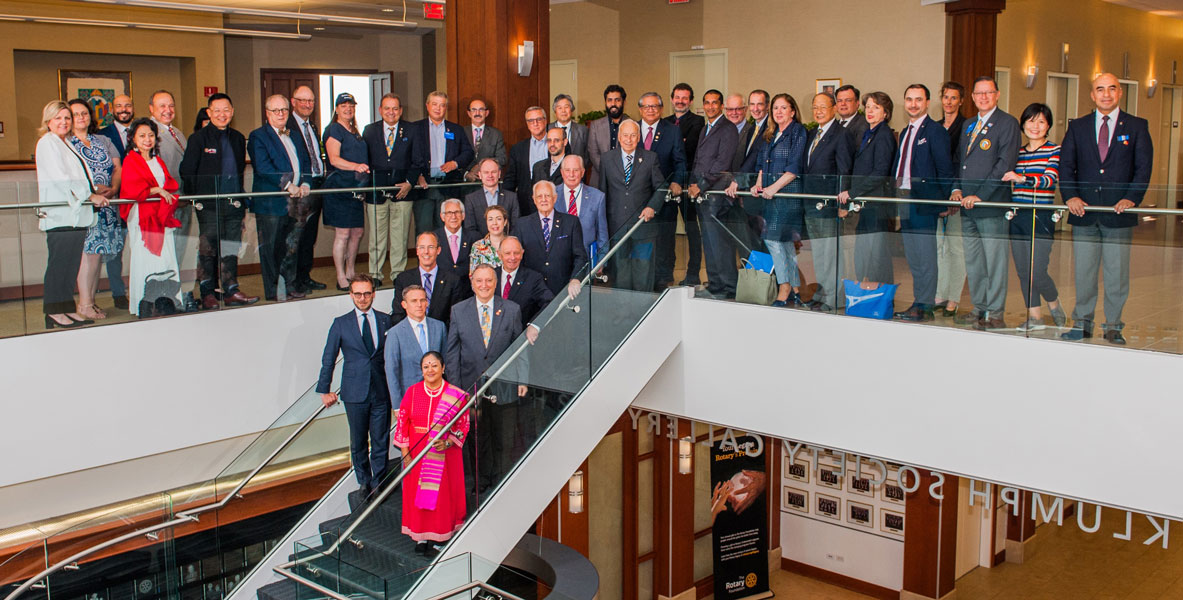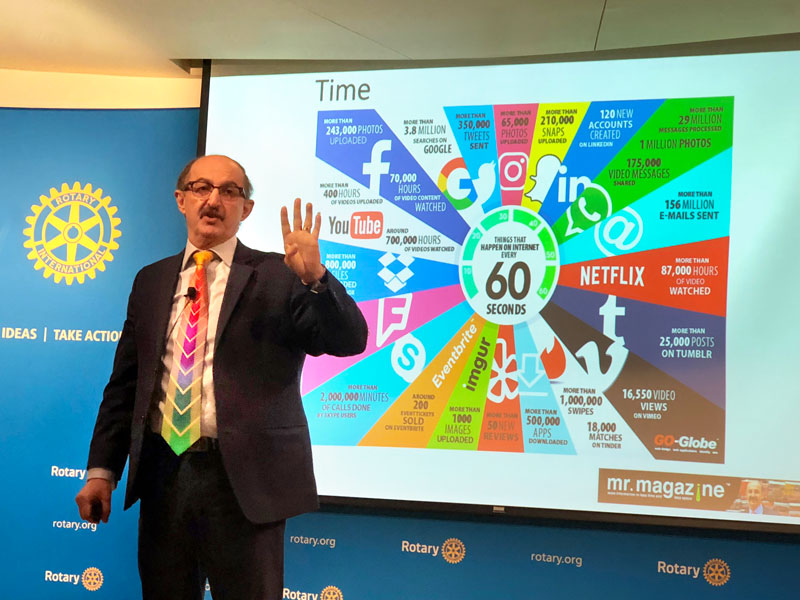Rotary Editors meet in Evanston

The one clear takeaway from the World Magazine Press Editors biennial meet was the need for all the 33 regional magazines to adopt a more uniform look and feel, particularly on the magazine covers.
Editors and Editorial board members from various regional magazines came together for the meet at the Rotary International Headquarters in Evanston where they exchanged notes, shared best practices and did some brainstorming on the road ahead.
In his videographed message, RI President Ian Riseley said, “Having a regular magazine on Rotary issues is important for our 1.2 million plus members around the world. As we mandate that Rotarians pay for the magazine, it is important to maintain a high standard and give value for money.”
Congratulating the regional editors for “the quality of magazines that you all bring out”, he said that he reviews most of the regional magazines every month “and I believe, as do most Rotarians, that the standard has improved significantly over the years.” Of course for the magazines published in languages other than English, he just looked at the pictures “but even those pictures are of superior quality”.
Riseley said that quality magazines also served the purpose of representing Rotary to the non-Rotary world and ensuring “we have an excellent public image and a well-regarded brand”.
I review most of the regional magazines every month and I believe, as do most Rotarians, that the standard has improved significantly over the years.
— RI President Ian Riseley
Over the years, the number of magazines had expanded “and I understand that more than half the members now receive a magazine that is specific to their region. That makes our magazines even more relevant to our membership.”
Much of the discussion at the conference was on the possibility of digital taking over from print in the coming years, but there were strong voices in support of print, including from John Bernaden, RI Communications Committee Vice-Chair, and moderator of the conference, who said that last year alone 700 new print magazines were started in North America alone. A friend of his had started a magazine two years ago just outside Chicago; “it goes to multi-million dollar homes, but he told me I don’t think people read it. It’s a coffee table magazine and a status symbol because if you have this magazine people think you are in the data base of the wealthy!”
Addressing the editors, RI General Secretary John Hewko said Rotary had 33 magazines printed in 22 languages in 130 countries and reached 700,000 Rotarians. He urged the editors to make the content of the magazine “so innovative, compelling and of a high quality that even though the subscription is mandatory, members should willingly and gladly buy the magazine.”
One of the important issues magazines should address was flexibility in club meetings. Even though the CoL had allowed such flexibility, many Rotary clubs did not really understand the concept of flexibility or how it worked in practice. As the RI President’s rep, he had visited many places where clubs thought that flexibility meant saving cost by reducing the number of meetings! Others had no idea what they should do to embrace flexibility.
But on the other hand, many clubs were adopting innovative approaches in embracing flexibility but this was not really known to everybody so the magazines should strive to write about clubs that had really introduced the flexi component in their club meetings.
The onus was on the magazines to educate Rotarians that there is no “Rotary police” watching what they do in their club meetings or how they do it, as long as the clubs continue to grow and make a difference to their communities. It would be a good idea to choose model clubs in different countries that best demonstrated the flexibility concept and write about them. Such models could be replicated by other clubs, said Hewko.
Brad Howard, RI Communications Committee Chair and co-moderator of the conference, said the regional magazines were the “primary voice” of what Rotary does across the world. For that a brand is very essential and the communications department had started “our brand exercise and went into the marketplace for a basic understanding of our brand essence.” The result was the ‘people of action’ campaign, “which is our core essence and fundamentally what we really are.” But RI depended hugely on the regional magazines to tell both Rotarians and non-Rotarians “who we are and what we do”.
The regional magazines were “an extraordinary network” which had an opportunity to come up with innovative content. And since the subscription to a Rotary magazine was mandatory, its quality levels should be maintained at a high level.
David Alexander, Chief Communications Officer, addressed the primary focus points of the seminar: improve quality and messaging, build a holistic approach to communication, define and use tools to keep our readers close, collaborate, and continue to move in the direction of providing a communications tool that that Rotarians need and value.
Be masters of storytelling

In an interesting session, Samir Husni, a leading magazine expert and analyst of the magazine industry, who is popularly known by the nickname ‘Mr Magazine’, made a huge case for print and said we lived in compelling times where there is an explosion of the social media, fake news and “a President who engages with the news through a twitter account. So when a President is tweeting and directly engaging with people, how about you? How are you, as journalists and editors, going to engage with the social media?”
It was challenging to be a journalist and an editor in this year because there are so many versions of the same news that “sometimes I wonder if something is wrong with my head, after I have watched reporting of the same incident on CNN and Fox News!”
Pooh-pooing doomsday scenarios projected on the death of the print media, he said once upon a time the iPad was supposed to be the salvation of content. Then came more and more sophisticated versions of the smart phones and everybody said print would soon die. But guess what? “For Hurst and Meredith (which recently bought Time Inc), two publishing giants, over 90 per cent of their revenue still comes from print. The magazine Better Homes and Gardens has a circulation of 7.6 million. Trust me, when you have that kind of a circulation, you’re making a lot of money.”
But to compete with the web world and social media which were so fast in disseminating information, “you will have to be smart, quick, and start knowing your audience… in your case, a captive audience.” But there were many challenges, a major one being the human being’s shrinking attention span. “It is amazing to see how little our attentions span is. It is estimated that Americans’ attention span has fallen from 12 to 8 seconds; if I can grab your attention in 8 seconds I’ve got you. That is why some advertisers on the social media are creating videos of 3, 4 or 5 seconds. By the way, the attention span of a goldfish is 10 seconds!”
But even with such a short attention span, “so many people are seeking our attention. Somebody is trying to reach you all the time… recently, at a bathroom at the Amsterdam airport, I saw myself facing an ad!”
Husni said there was a set of statistics that said that “it will take you continuous four years of watching to see what is uploaded on YouTube in one day. So let’s have a YouTube binge party for the next four years!” Similarly, on Netflix, in one minute 87,000 hours of video is watched. Add to this Facebook, Snapchat and so many other apps, and the scenario is mindboggling. There is no red light on the social media… only green lights and the information just keeps coming…”
But in the midst of all this electronic information, print was holding good. Giving the example of the recent royal wedding featuring an “American Princess” (Meghan Markle), print magazines were in a tizzy to score over each other. Time magazine changed its publishing schedule from Friday to Wednesday because it wanted to be the first on the newsstands with this story. Magazines raised their cover prices. “Everybody wanted to have a piece of the action, and this American princess in my home.”
He urged the editors to never forget that “print… either books or magazines… and audiences have a relationship… you are in the relationship business, and the difference between print and digital is like that between a one-night stand or a love affair and life-long marriage!”
Print would always remain relevant, said Husni, but with a caveat; “good content is no longer enough. You will have to provide an experience.” If magazines did that, there will still be takers. The average price of a magazine these days in the US was $13, and people were willing to pay that for information of value and an experience.
Predicting that both the print and digital media would coexist for a long time, he said that for most digital publications, advertisements came only in dribbles. “Google and Facebook receive more than 85 per cent of all the digital dollars out there. The rest of the entire digital media has to fight for the remaining 15 per cent.”
Husni also warned editors: “Don’t think digital is the haven or answer for a sick print product”. A bad product, whether print or digital, would not survive in the marketplace.
His sane advice was to offer a judicious mix of both the print and digital mediums. “If I am reading The Economist or War and Peace on a flight, I want it in my hand, because I want people to see the hard copy and say: ‘Wow this guy is a smart guy.’ But if I want to read the Playboy, I will do it on my iPad!”
His parting shot to remain compelling and relevant: “Be masters of storytelling… tell the story of children without clean water in such a compelling way so as to make people get off the chair, keep aside their glass of wine and take action…”
